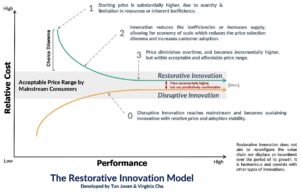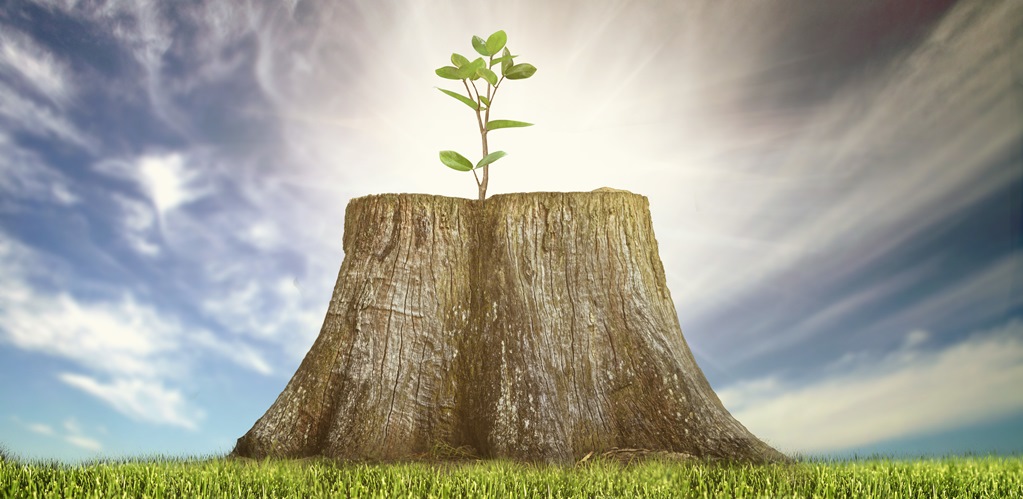This article by Jovan Tan and Virginia Cha echoes some of the concepts originally published in The Restoration Economy back in 2002, and more recently in RECONOMICS: The Path To Resilient Prosperity, published in 2020.
Jovan Tan is the Fellow, Shaping the Future of Advanced Manufacturing and Value Chains, at the World Economic Forum. Virginia Cha is a Member of the Global Future Council, Shaping the Future of Advanced Manufacturing and Value Chains at the World Economic Forum.
Lately, humanity has witnessed a surge in introducing and adopting renewable energy sources, alternative proteins, low-carbon materials, and many technological advancements to solve our world’s most pressing issues. These innovations contribute to improving the state of the world.
Lack of economic models to understand successful innovations.
 However, there is a lack of a robust and predictable economic model to justify and anticipate returns from continued investments in developing and bringing these nascent innovations to market.
However, there is a lack of a robust and predictable economic model to justify and anticipate returns from continued investments in developing and bringing these nascent innovations to market.
Without a good profit formula or visibility on expected returns, these innovations may struggle to garner critical support from key stakeholders, such as investors and partners, to achieve economic viability, and scale beyond their initial market, even with all the best intentions.
Disruptive Innovation, a model developed by the late Clayton Christensen, enjoys widespread support and adoption as it predicts how innovations can replace their mainstream counterpart under certain circumstances.
Despite the existence of several innovation models, none could confidently project and explain the growth pattern of these emerging innovations.
This is why it’s crucial to introduce a new innovation model that thoroughly considers the unique traits and interactions needed for these emerging innovations to grow and translate their desired impact on society.
What is “restorative innovation”?
In 2017, we developed the Restorative Innovation model to explain the growth patterns of these emerging innovations designed to improve the state of the world.
Fundamentally, innovations will translate their desired impacts and benefits to our society if enough people adopt them. However, while we all desire to be conscientious consumers who embrace the healthiest, most humane, and most environmentally friendly goods and services available, we may not always do so as these options tend to be prohibitively more expensive, inaccessible to mass consumers, or unavailable.
We need to dramatically bring down the cost – or green premium – of these innovative solutions to convince enough early adopters to switch. Our research demonstrates that the switch-over effect occurs between a 30% to 50% premium over mainstream goods. Therefore, unless the conscientious good is within this acceptable price range, many consumers will end up suppressing their desire to satisfy their latent needs and instead anchor to what is mass-produced and widely available.
To achieve a final price acceptable to mass consumers like us, we need impact-driven leaders championing these restorative innovations to pursue strategies to reduce the overall cost of production. The restorative innovation model wants to illustrate how to reduce the costs of innovation.
Our research established three vital levers that impact-driven leaders must focus on and act expeditiously to reduce the intrinsic cost of their innovation. First, they need to ramp up their production availability and capacity. Next, they need to eliminate inherent inefficiencies and optimize their supply chain. Lastly, they need to fervently drive the adoption of their innovation with robust go-to-market strategies.
Why does it matter?
As for consumers like us, we need to collectively advocate and support their pursuit by adopting their innovative solutions and encouraging our politicians to introduce targeted policy action to accelerate its market adoption. Conceivably, this will significantly strengthen the product’s appeal and attract other like-minded consumers to switch over from existing mass-market alternatives and adopt solutions that cater to their latent needs.
To witness restorative innovation in action, we can turn to the once nascent solar energy industry. The vast demand for solar energy arose when consumers, businesses, and politicians recognized society’s immediate need to decarbonize and replace fossil fuel-based energy sources. With that, we witnessed a period where key stakeholders passionately rallied behind solar energy as a viable alternative. These highly concerted efforts enabled policymakers to introduce various incentive schemes to support the widespread adoption of solar energy systems.
With strong participation from key stakeholders in this movement, we witnessed the ramp-up of solar photovoltaic capacity, availability, and efficiency in manufacturing and deploying it. The total solar energy output rose exponentially within a decade. In tandem, the unit cost of solar energy plummeted from US$0.50 per kilowatt-hour to US$0.01 and US$0.02 per kilowatt-hour in the same period.
Apart from solar energy systems, other notable innovations like bioplastics, lab-grown meat, and even electric cars following the Restorative Innovation growth pattern are undergoing the same transformation. Hence, we must integrate and apply the insights of the Restorative Innovation model to propel and proliferate deserving innovative solutions to better our society.
Paving the way for restorative innovations to hit the markets.
Innovation can be magical. It has the potential to reduce the unprecedented resource stress on our planet and solve the many challenges humanity faces while creating vast new economic opportunities for businesses to capitalize and prosper.
Therefore, we offer this framework to pave the way for a new set of possibilities. Restorative innovation provides entrepreneurs and innovators with a way forward to explain how their innovative solutions can bring profits and returns to investors.
This paves the way for more capital to develop restorative innovations, get them to the market and deliver a positive impact for society.
Image via Pixabay.

